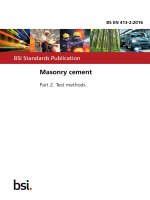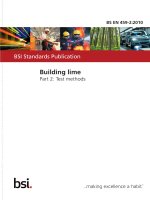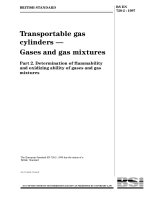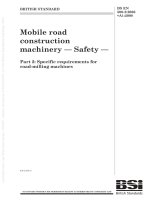Bsi bs en 61300 2 9 2017
Bạn đang xem bản rút gọn của tài liệu. Xem và tải ngay bản đầy đủ của tài liệu tại đây (2.07 MB, 18 trang )
BS EN 61300-2-9:2017
BSI Standards Publication
Fibre optic interconnecting
devices and passive
components — Basic test
and measurement procedures
Part 2-9: Tests — Shock
BRITISH STANDARD
BS EN 61300-2-9:2017
National foreword
This British Standard is the UK implementation of EN 61300-2-9:2017. It is
identical to IEC 61300-2-9:2017. It supersedes BS EN 61300-2-9:2010 which
is withdrawn.
The UK participation in its preparation was entrusted by Technical
Committee GEL/86, Fibre optics, to Subcommittee GEL/86/2, Fibre optic
interconnecting devices and passive components.
A list of organizations represented on this committee can be obtained on
request to its secretary.
This publication does not purport to include all the necessary provisions of
a contract. Users are responsible for its correct application.
© The British Standards Institution 2017.
Published by BSI Standards Limited 2017
ISBN 978 0 580 86299 1
ICS 33.180.20
Compliance with a British Standard cannot confer immunity from
legal obligations.
This British Standard was published under the authority of the
Standards Policy and Strategy Committee on 31 March 2017.
Amendments/corrigenda issued since publication
Date
Text affected
BS EN 61300-2-9:2017
EUROPEAN STANDARD
EN 61300-2-9
NORME EUROPÉENNE
EUROPÄISCHE NORM
March 2017
ICS 33.180.20
Supersedes EN 61300-2-9:2010
English Version
Fibre optic interconnecting devices and passive components Basic test and measurement procedures - Part 2-9: Tests Shock
(IEC 61300-2-9:2017)
Dispositifs d'interconnexion et composants passifs à fibres
optiques - Méthodes fondamentales d'essais et de mesures
- Partie 2-9: Essais - Chocs
(IEC 61300-2-9:2017)
Lichtwellenleiter - Verbindungselemente und passive
Bauelemente - Grundlegende Prüf- und Messverfahren Teil 2-9: Prüfungen - Schocken
(IEC 61300-2-9:2017)
This European Standard was approved by CENELEC on 2017-02-10. CENELEC members are bound to comply with the CEN/CENELEC
Internal Regulations which stipulate the conditions for giving this European Standard the status of a national standard without any alteration.
Up-to-date lists and bibliographical references concerning such national standards may be obtained on application to the CEN-CENELEC
Management Centre or to any CENELEC member.
This European Standard exists in three official versions (English, French, German). A version in any other language made by translation
under the responsibility of a CENELEC member into its own language and notified to the CEN-CENELEC Management Centre has the
same status as the official versions.
CENELEC members are the national electrotechnical committees of Austria, Belgium, Bulgaria, Croatia, Cyprus, the Czech Republic,
Denmark, Estonia, Finland, Former Yugoslav Republic of Macedonia, France, Germany, Greece, Hungary, Iceland, Ireland, Italy, Latvia,
Lithuania, Luxembourg, Malta, the Netherlands, Norway, Poland, Portugal, Romania, Serbia, Slovakia, Slovenia, Spain, Sweden,
Switzerland, Turkey and the United Kingdom.
European Committee for Electrotechnical Standardization
Comité Européen de Normalisation Electrotechnique
Europäisches Komitee für Elektrotechnische Normung
CEN-CENELEC Management Centre: Avenue Marnix 17, B-1000 Brussels
© 2017 CENELEC All rights of exploitation in any form and by any means reserved worldwide for CENELEC Members.
Ref. No. EN 61300-2-9:2017 E
BS EN 61300-2-9:2017
EN 61300-2-9:2017
European foreword
The text of document 86B/3979/CDV, future edition 3 of IEC 61300-2-9, prepared by SC 86B "Fibre
optic interconnecting devices and passive components" of IEC/TC 86 "Fibre optics" was submitted to
the IEC-CENELEC parallel vote and approved by CENELEC as EN 61300-2-9:2017.
The following dates are fixed:
•
latest date by which the document has to be implemented at
national level by publication of an identical national
standard or by endorsement
(dop)
2017-11-10
•
latest date by which the national standards conflicting with
the document have to be withdrawn
(dow)
2018-02-10
This document supersedes EN 61300-2-9:2010.
Attention is drawn to the possibility that some of the elements of this document may be the subject of
patent rights. CENELEC [and/or CEN] shall not be held responsible for identifying any or all such
patent rights.
Endorsement notice
The text of the International Standard IEC 61300-2-9:2017 was approved by CENELEC as a
European Standard without any modification.
In the official version, for Bibliography, the following notes have to be added for the standards indicated:
2
IEC 60068-2-27:2008
NOTE
Harmonized as EN 60068-2-27:2009.
IEC 60068-2-47:2005
NOTE
Harmonized as EN 60664-1:2007.
IEC 61300-3-3
NOTE
Harmonized as EN 61300-3-3.
BS EN 61300-2-9:2017
EN 61300-2-9:2017
Annex ZA
(normative)
Normative references to international publications
with their corresponding European publications
The following documents, in whole or in part, are normatively referenced in this document and are
indispensable for its application. For dated references, only the edition cited applies. For undated
references, the latest edition of the referenced document (including any amendments) applies.
NOTE 1 When an International Publication has been modified by common modifications, indicated by (mod), the relevant
EN/HD applies.
NOTE 2 Up-to-date information on the latest versions of the European Standards listed in this annex is available here:
www.cenelec.eu.
Publication
IEC 60068-1
Year
-
IEC 61300-1
-
IEC 61300-3-1
-
IEC 61300-3-28
-
ISO 2041
-
Title
EN/HD
Environmental testing -- Part 1: GeneralEN 60068-1
and guidance
Fibre optic interconnecting devices andEN 61300-1
passive components - Basic test and
measurement procedures - Part 1: General
and guidance
Fibre optic interconnecting devices andEN 61300-3-1
passive components - Basic test and
measurement procedures -- Part 3-1:
Examinations and measurements - Visual
examination
Fibre optic interconnecting devices andEN 61300-3-28
passive components - Basic test and
measurement procedures -- Part 3-28:
Examinations
and
measurements
Transient loss
Mechanical vibration, shock and conditionmonitoring - Vocabulary
Year
-
-
-
-
3
–2–
BS EN 61300-2-9:2017
IEC 61300-2-9:2017 © IEC 2017
CONTENTS
FOREWORD ........................................................................................................................... 3
1
Scope .............................................................................................................................. 5
2
Normative references ...................................................................................................... 5
3
Terms and definitions ...................................................................................................... 5
4
General description ......................................................................................................... 7
5
Apparatus ........................................................................................................................ 7
5.1
Shock machine ....................................................................................................... 7
5.1.1
General ........................................................................................................... 7
5.1.2
Repetition rate ................................................................................................. 8
5.1.3
Velocity change tolerances .............................................................................. 8
5.1.4
Cross axis motion ............................................................................................ 8
5.1.5
Acceleration measuring system ....................................................................... 8
5.2
Mounting fixture ...................................................................................................... 9
5.3
Optical power measuring equipment ....................................................................... 9
6
Procedure ........................................................................................................................ 9
6.1
Preparation of DUT ................................................................................................. 9
6.2
Pre-conditioning .................................................................................................... 10
6.3
Initial examinations and measurements ................................................................. 10
6.4
Testing ................................................................................................................. 10
6.5
Recovery .............................................................................................................. 10
6.6
Final examination and measurements ................................................................... 10
7
Shock severity ............................................................................................................... 11
8
Details to be specified ................................................................................................... 11
Bibliography .......................................................................................................................... 12
Figure 1 – Fixing points .......................................................................................................... 6
Figure 2 – Pulse shape and limits of tolerance for half-sine pulse ........................................... 7
Figure 3 – Frequency characteristics of the overall measuring system without low-pass
filter ........................................................................................................................................ 9
Table 1 – Required frequency characteristic values for the overall measuring system ............ 9
Table 2 – Severity for passive components and modules ...................................................... 11
Table 3 – Severity for fibre management systems and closures ............................................ 11
BS EN 61300-2-9:2017
IEC 61300-2-9:2017 © IEC 2017
–3–
INTERNATIONAL ELECTROTECHNICAL COMMISSION
____________
FIBRE OPTIC INTERCONNECTING
DEVICES AND PASSIVE COMPONENTS –
BASIC TEST AND MEASUREMENT PROCEDURES –
Part 2-9: Tests – Shock
FOREWORD
1) The International Electrotechnical Commission (IEC) is a worldwide organization for standardization comprising
all national electrotechnical committees (IEC National Committees). The object of IEC is to promote
international co-operation on all questions concerning standardization in the electrical and electronic fields. To
this end and in addition to other activities, IEC publishes International Standards, Technical Specifications,
Technical Reports, Publicly Available Specifications (PAS) and Guides (hereafter referred to as "IEC
Publication(s)"). Their preparation is entrusted to technical committees; any IEC National Committee interested
in the subject dealt with may participate in this preparatory work. International, governmental and nongovernmental organizations liaising with the IEC also participate in this preparation. IEC collaborates closely
with the International Organization for Standardization (ISO) in accordance with conditions determined by
agreement between the two organizations.
2) The formal decisions or agreements of IEC on technical matters express, as nearly as possible, an international
consensus of opinion on the relevant subjects since each technical committee has representation from all
interested IEC National Committees.
3) IEC Publications have the form of recommendations for international use and are accepted by IEC National
Committees in that sense. While all reasonable efforts are made to ensure that the technical content of IEC
Publications is accurate, IEC cannot be held responsible for the way in which they are used or for any
misinterpretation by any end user.
4) In order to promote international uniformity, IEC National Committees undertake to apply IEC Publications
transparently to the maximum extent possible in their national and regional publications. Any divergence
between any IEC Publication and the corresponding national or regional publication shall be clearly indicated in
the latter.
5) IEC itself does not provide any attestation of conformity. Independent certification bodies provide conformity
assessment services and, in some areas, access to IEC marks of conformity. IEC is not responsible for any
services carried out by independent certification bodies.
6) All users should ensure that they have the latest edition of this publication.
7) No liability shall attach to IEC or its directors, employees, servants or agents including individual experts and
members of its technical committees and IEC National Committees for any personal injury, property damage or
other damage of any nature whatsoever, whether direct or indirect, or for costs (including legal fees) and
expenses arising out of the publication, use of, or reliance upon, this IEC Publication or any other IEC
Publications.
8) Attention is drawn to the Normative references cited in this publication. Use of the referenced publications is
indispensable for the correct application of this publication.
9) Attention is drawn to the possibility that some of the elements of this IEC Publication may be the subject of
patent rights. IEC shall not be held responsible for identifying any or all such patent rights.
International Standard IEC 61300-2-9 has been prepared by subcommittee 86B: Fibre optic
interconnecting devices and passive components, of IEC technical committee 86: Fibre optics.
This third edition cancels and replaces the second edition published in 2010. This edition
constitutes a technical revision.
This edition includes the following significant technical changes with respect to the previous
edition:
a) inserted clause "Terms and definitions";
b) added precise descriptions to clause "Apparatus";
c) added sub clause "Testing" into clause "Procedure";
d) added "Bibliography".
–4–
BS EN 61300-2-9:2017
IEC 61300-2-9:2017 © IEC 2017
The text of this International Standard is based on the following documents:
CDV
Report on voting
86B/3979/CDV
86B/4017/RVC
Full information on the voting for the approval of this International Standard can be found in
the report on voting indicated in the above table.
This document has been drafted in accordance with the ISO/IEC Directives, Part 2.
A list of all parts in the IEC 61300 series, published under the general title Fibre optic
interconnecting devices and passive components, can be found on the IEC website.
The committee has decided that the contents of this document will remain unchanged until the
stability date indicated on the IEC website under "" in the data related to
the specific document. At this date, the document will be
•
reconfirmed,
•
withdrawn,
•
replaced by a revised edition, or
•
amended.
A bilingual version of this publication may be issued at a later date.
IMPORTANT – The 'colour inside' logo on the cover page of this publication indicates
that it contains colours which are considered to be useful for the correct
understanding of its contents. Users should therefore print this document using a
colour printer.
BS EN 61300-2-9:2017
IEC 61300-2-9:2017 © IEC 2017
–5–
FIBRE OPTIC INTERCONNECTING
DEVICES AND PASSIVE COMPONENTS –
BASIC TEST AND MEASUREMENT PROCEDURES –
Part 2-9: Tests – Shock
1
Scope
This part of IEC 61300 defines a test method to reveal mechanical weakness and/or
degradation of fibre optic devices when subjected to repetitive or non-repetitive mechanical
shocks. It simulates infrequent repetitive or non-repetitive shocks likely to be encountered in
normal service or during transportation.
2
Normative references
The following documents are referred to in the text in such a way that some or all of their
content constitutes requirements of this document. For dated references, only the edition
cited applies. For undated references, the latest edition of the referenced document (including
any amendments) applies.
IEC 60068-1, Environmental testing – Part 1: General and guidance
IEC 61300-1, Fibre optic interconnecting devices and passive components – Basic test and
measurement procedures – Part 1: General and guidance
IEC 61300-3-1, Fibre optic interconnecting devices and passive components – Basic test and
measurement procedures – Part 3-1: Examinations and measurements – Visual examination
IEC 61300-3-28, Fibre optic interconnecting devices and passive components – Basic test
and measurement procedures – Part 3-28: Examinations and measurements – Transient loss
ISO 2041, Mechanical vibration, shock and condition monitoring – Vocabulary
3
Terms and definitions
For the purposes of this document, the terms and definitions given in ISO 2041 and
IEC 60068-1 apply.
ISO and IEC maintain terminological databases for use in standardization at the following
addresses:
•
IEC Electropedia: available at />
•
ISO Online browsing platform: available at />
3.1
check point
point located on the fixture, on the table surface of the shock machine, or on the DUT as
close as possible to the fixing point and rigidly connected to it
Note 1 to entry
A number of check points may be used to ensure the test requirements are satisfied.
Note 2 to entry If the DUT is attached by more than four fixing points, the relevant specification should state the
number of fixing points that are to be used as check points.
BS EN 61300-2-9:2017
IEC 61300-2-9:2017 © IEC 2017
–6–
Note 3 to entry In special cases, for example, for large or complex DUTs, the check points will be prescribed by
the relevant specification.
Note 4 to entry If a small DUT is mounted on one fixture or a large number of small DUTs are mounted on one
fixture, or where there are a number of fixing points, a single check point (that is the reference point) may be
selected for the derivation of the control signal. This signal is then related to the fixture rather than to the fixing
points of the DUT(s). This procedure is only valid when the lowest resonance frequency of the loaded fixture is well
above the upper frequency of the test.
3.2
fixing point
point on the DUT in contact with the fixture (Figure 1a) or the table of the shock machine at a
location where the DUT is normally fastened in service
Note 1 to entry If a part of the real mounting structure is used as the fixture, the fixing points are taken as those
where the real mounting structure contacts the table (Figure 1b) and not where the product contacts the real
mounting structure.
DUT
Fixing points
Fixture
Table of shock-testing machine
IEC
a) Fixing points using a fixture
DUT
Real mounting structure
Fixing points
Table of shock-testing machine
IEC
b) Fixing points using a real mounting structure as a fixture
Figure 1 – Fixing points
3.3
repetition rate
number of shocks per second
3.4
shock severity
combination of the peak acceleration, the duration of the nominal pulse and the number of
shocks
BS EN 61300-2-9:2017
IEC 61300-2-9:2017 © IEC 2017
–7–
3.5
velocity change
absolute value of the sudden change of velocity resulting from the application of the specified
acceleration
4
General description
A device under test (DUT) is mounted on the table of the shock machine and is subjected to
half-sinusoidal shock pulses. The DUT is exposed to two or three shock pulses applied in
each direction of three mutually perpendicular axes in accordance with severities (see
Clause 7).
Wherever possible, the severity of the pulse applied to the DUT should be such as to
reproduce the effects of the actual transport or operational environment to which the DUT will
be subjected, or to satisfy the design requirements. The DUT is always mounted to the fixture
or the table of the shock machine during testing.
5
Apparatus
5.1
Shock machine
5.1.1
General
The shock machine may be of the free fall, resilient rebound, nonresilient, hydraulic,
compressed gas or other activating type. The shock machine shall be capable of generating a
calibrated acceleration when loaded with a DUT, with or without a fixture. The shock machine
shall be capable of generating a half-sinusoidal excitation measured at the checkpoints, within
the tolerance shown by the solid lines in Figure 2.
Integration time
1,5 D
Acceleration (relative value)
1,2 A
A
0,8 A
+0,2 A
0,2 A
0,2 A
0
–0,2 A
0
–0,2 A
0,1 D
0,4 D
D
2,5 D
D
2,5 D
2,4 D = T 1
6 D = T2
Time (relative value)
IEC
Key
–––
nominal pulse
A=
peak acceleration of nominal pulse
tolerence
T1 =
minimum time during which the pulse shall be monitored for shocks produced using a conventional shock
machine
D=
duration of nominal pulse
T2 =
minimum time during which the pulse shall be monitored for shocks produced using a vibration generator
Figure 2 – Pulse shape and limits of tolerance for half-sine pulse
–8–
5.1.2
BS EN 61300-2-9:2017
IEC 61300-2-9:2017 © IEC 2017
Repetition rate
The repetition rate shall be such that the relative motion within the DUT between shocks shall
be substantially zero and the value of acceleration at the check point shall be within the limits
shown in Figure 2.
5.1.3
Velocity change tolerances
For all pulse shapes, the actual velocity change shall be within ±15 % of the value
corresponding to the nominal pulse.
Where the velocity change is determined by integration of the actual acceleration pulse, this
shall be effected from 0,4 D before the pulse to 0,1 D beyond the pulse, where D is the
duration of the nominal pulse.
If the velocity change tolerance cannot be achieved without the use of elaborate facilities, the
relevant specification shall state the alternative procedure to be adopted.
5.1.4
Cross axis motion
The positive or negative peak acceleration at the check point(s), perpendicular to the intended
shock direction, shall not exceed 30 % of the value of the peak acceleration of the nominal
pulse in the intended direction, when determined by 5.1.5.
If the cross axis motion tolerance cannot be achieved, the relevant specification shall state
the alternative procedure to be adopted.
5.1.5
Acceleration measuring system
The characteristics of the measuring system shall be such that it can be determined that the
true value of the actual pulse, as measured above, in the intended direction at the
checkpoint(s) is within the tolerances required by Figure 2.
The requirements of Figure 3 apply to the frequency response of the measuring system
without the use of a low-pass filter on the control signal. When a low-pass filter is used, the
characteristics of the filter should be such that its cut-off frequency fg (–3 dB point) is not
lower than:
fg =
1,5
D
where
fg is the cut-off frequency of a low-pass filter in kHz;
D is the duration of nominal pulse in ms.
The frequency response of the overall measuring system, which includes the accelerometer,
can have a significant effect on the accuracy and shall be within the limits shown in Figure 3
and Table 1.
BS EN 61300-2-9:2017
IEC 61300-2-9:2017 © IEC 2017
–9–
+1
Acceleration (relative value) (dB)
0
–1
24 dB/octave
–10
f1
f2
f3
f4
Frequency (Hz)
IEC
Figure 3 – Frequency characteristics of the overall measuring system
without low-pass filter
Table 1 – Required frequency characteristic values
for the overall measuring system
Duration of pulse
Low-frequency
cut-off
High-frequency
cut-off
Frequency beyond
which the response may
rise above +1 dB
ms
Hz
kHz
kHz
D
f1
f2
f3
f4
1
4
20
10
20
11
0,5
2
1
2
SOURCE: adapted from IEC 60068-2-27:2008
5.2
Mounting fixture
The DUT shall be prepared and mounted with accessories as specified in the relevant
specification and fastened to the table of the shock machine.
5.3
Optical power measuring equipment
Unless otherwise specified, measuring equipment specified in IEC 61300-3-28 shall be
connected to the DUT for monitoring the transient loss to detect fast variation of attenuation.
6
6.1
Procedure
Preparation of DUT
Prepare the DUT according to the manufacturer´s instructions or as specified in the relevant
specification.
– 10 –
6.2
BS EN 61300-2-9:2017
IEC 61300-2-9:2017 © IEC 2017
Pre-conditioning
Pre-condition the DUT for 2 h at the standard atmospheric condition specified in IEC 61300-1
unless otherwise specified in the relevant specification.
6.3
Initial examinations and measurements
Complete initial examinations and measurements of the DUT as required by the relevant
specification.
6.4
Testing
The DUT shall be mounted rigidly to the fixture in a manner that simulates normal mounting
as closely as possible. A minimum length of 200 mm of optical fibre/cable shall be
unsupported on both ends of the DUT and be attached free of tension to the table of a shock
machine. Conduct the procedure as outlined in 6.5 and 6.6.
The number of shocks prescribed by the relevant specification shall be applied successively
in each direction of three mutually perpendicular axes of the DUT. When testing a number of
identical DUTs, they may be oriented so that the shocks are applied simultaneously along
these three axes (see Clause 7).
Where the position of the DUT, when mounted or transported, is known, and since shocks are
generally of greatest significance in one direction of one axis, the relevant specification shall
state the specified number of shocks that shall be applied and in which axis, direction and
position. Otherwise, three axes and two directions shall be tested. For example, usually the
highest levels of shock acceleration are along the vertical axis. When the position during
transportation is known, the shocks should be applied in what will be the vertical axis in the
upward direction. Where the position is unknown, the specified number of shocks shall be
applied in each of the axes prescribed by the relevant specification (see Clause 7).
The relevant specification shall state whether the DUT shall operate during testing and if any
functional monitoring is required.
6.5
Recovery
Allow the DUT to remain on the fixture for 1 min unless otherwise specified in the relevant
specification.
6.6
Final examination and measurements
On completion of the test, remove all fixtures, clean the DUT in accordance with the
manufacturer’s instruction and inspect the DUT and make final measurements as defined by
the relevant specification, to ensure that there is no permanent damage to the DUT. The
relevant specification shall provide the criteria upon which the acceptance or rejection of the
DUT shall be based.
Unless otherwise specified, visually examine the DUT in accordance with IEC 61300-3-1.
Check for evidence of any degradation in the DUT. This may include, for example
•
broken, loose or damaged parts and/or accessories,
•
broken or damaged cable sheath, seals, strain relief or fibres, and
•
displaced, bent, broken or damaged parts.
BS EN 61300-2-9:2017
IEC 61300-2-9:2017 © IEC 2017
7
– 11 –
Shock severity
The Shock severity consists of the combination of peak acceleration, the duration of the
nominal pulse and number of shocks. The severity shall be specified in the relevant
specification. Recommended values of the test parameters are given in Tables 2 and 3.
Table 2 – Severity for passive components and modules
Parameter
Value
Wave form
Half sinusoidal
Acceleration
Component or module mass ≤ 0,125 kg:
5 000 m/s 2
Modules:
2 000 m/s 2 for: 0,125 kg < module mass ≤ 0,225 kg
500 m/s 2 for: 0,225 kg < module mass ≤ 1 kg
Duration
1 ms
Number of shocks
2 directions, 2 shocks per axis
Number of axes
3 mutually perpendicular
Table 3 – Severity for fibre management systems and closures
Parameter
Value
Wave form
Half sinusoidal
Acceleration
150 m/s 2
Duration
11 ms
Number of shocks
2 directions, 3 shocks per axis
Number of axes
3 mutually perpendicular
8
Details to be specified
The following details, as applicable, shall be specified in the relevant specification:
•
initial examinations and measurements and performance requirements;
•
examinations and measurements during test and performance requirements;
•
final examinations and measurements and performance requirements;
•
deviations from test procedure;
•
additional pass/fail criteria;
•
test conditions.
– 12 –
BS EN 61300-2-9:2017
IEC 61300-2-9:2017 © IEC 2017
Bibliography
IEC 60068-2-27:2008, Environmental testing – Part 2-27: Tests – Test Ea and guidance:
Shock
IEC 60068-2-47:2005, Environmental testing – Part 2-47: Test – Mounting of specimens for
vibration, impact and similar dynamic tests
IEC 61300-3-3, Fibre optic interconnecting devices and passive components – Basic test and
measurement procedures – Part 3-3: Examinations and measurements – Active monitoring of
changes in attenuation and return loss
IEC TR 62343-6-5:2014, Dynamic modules – Part 6-5: Design guide – Investigation of
operating mechanical shock and vibration tests for dynamic modules
Guide 104, The preparation of safety publications and the use of basic safety publications and
group safety publications
___________
This page deliberately left blank
NO COPYING WITHOUT BSI PERMISSION EXCEPT AS PERMITTED BY COPYRIGHT LAW
British Standards Institution (BSI)
BSI is the national body responsible for preparing British Standards and other
standards-related publications, information and services.
BSI is incorporated by Royal Charter. British Standards and other standardization
products are published by BSI Standards Limited.
About us
Reproducing extracts
We bring together business, industry, government, consumers, innovators
and others to shape their combined experience and expertise into standards
-based solutions.
For permission to reproduce content from BSI publications contact the BSI
Copyright & Licensing team.
The knowledge embodied in our standards has been carefully assembled in
a dependable format and refined through our open consultation process.
Organizations of all sizes and across all sectors choose standards to help
them achieve their goals.
Information on standards
We can provide you with the knowledge that your organization needs
to succeed. Find out more about British Standards by visiting our website at
bsigroup.com/standards or contacting our Customer Services team or
Knowledge Centre.
Buying standards
You can buy and download PDF versions of BSI publications, including British
and adopted European and international standards, through our website at
bsigroup.com/shop, where hard copies can also be purchased.
If you need international and foreign standards from other Standards Development
Organizations, hard copies can be ordered from our Customer Services team.
Copyright in BSI publications
All the content in BSI publications, including British Standards, is the property
of and copyrighted by BSI or some person or entity that owns copyright in the
information used (such as the international standardization bodies) and has
formally licensed such information to BSI for commercial publication and use.
Save for the provisions below, you may not transfer, share or disseminate any
portion of the standard to any other person. You may not adapt, distribute,
commercially exploit, or publicly display the standard or any portion thereof in any
manner whatsoever without BSI’s prior written consent.
Storing and using standards
Standards purchased in soft copy format:
• A British Standard purchased in soft copy format is licensed to a sole named
user for personal or internal company use only.
• The standard may be stored on more than 1 device provided that it is accessible
by the sole named user only and that only 1 copy is accessed at any one time.
• A single paper copy may be printed for personal or internal company use only.
Standards purchased in hard copy format:
• A British Standard purchased in hard copy format is for personal or internal
company use only.
• It may not be further reproduced – in any format – to create an additional copy.
This includes scanning of the document.
If you need more than 1 copy of the document, or if you wish to share the
document on an internal network, you can save money by choosing a subscription
product (see ‘Subscriptions’).
Subscriptions
Our range of subscription services are designed to make using standards
easier for you. For further information on our subscription products go to
bsigroup.com/subscriptions.
With British Standards Online (BSOL) you’ll have instant access to over 55,000
British and adopted European and international standards from your desktop.
It’s available 24/7 and is refreshed daily so you’ll always be up to date.
You can keep in touch with standards developments and receive substantial
discounts on the purchase price of standards, both in single copy and subscription
format, by becoming a BSI Subscribing Member.
PLUS is an updating service exclusive to BSI Subscribing Members. You will
automatically receive the latest hard copy of your standards when they’re
revised or replaced.
To find out more about becoming a BSI Subscribing Member and the benefits
of membership, please visit bsigroup.com/shop.
With a Multi-User Network Licence (MUNL) you are able to host standards
publications on your intranet. Licences can cover as few or as many users as you
wish. With updates supplied as soon as they’re available, you can be sure your
documentation is current. For further information, email
Revisions
Our British Standards and other publications are updated by amendment or revision.
We continually improve the quality of our products and services to benefit your
business. If you find an inaccuracy or ambiguity within a British Standard or other
BSI publication please inform the Knowledge Centre.
Useful Contacts
Customer Services
Tel: +44 345 086 9001
Email (orders):
Email (enquiries):
Subscriptions
Tel: +44 345 086 9001
Email:
Knowledge Centre
Tel: +44 20 8996 7004
Email:
Copyright & Licensing
Tel: +44 20 8996 7070
Email:
BSI Group Headquarters
389 Chiswick High Road London W4 4AL UK









